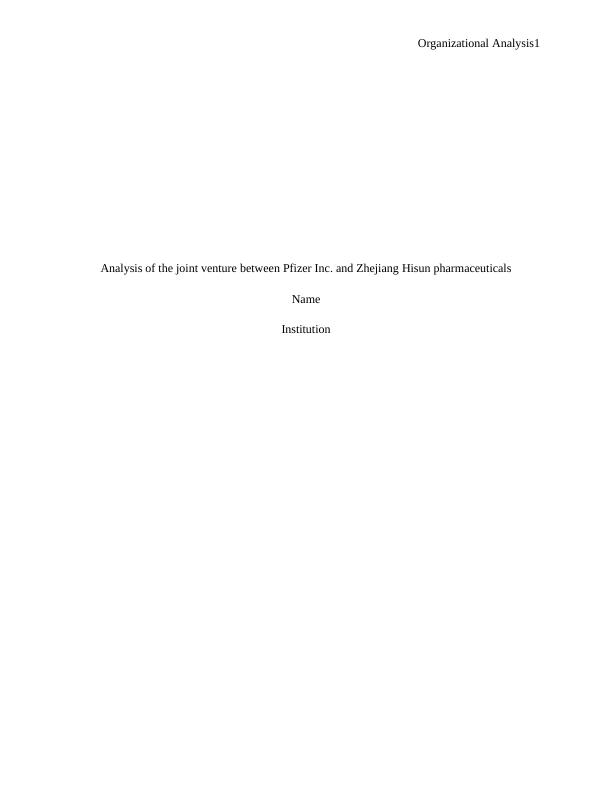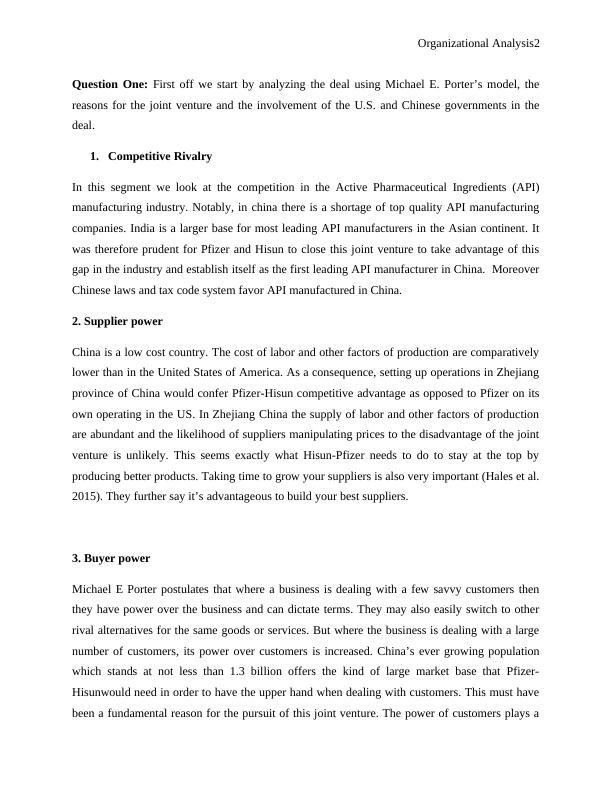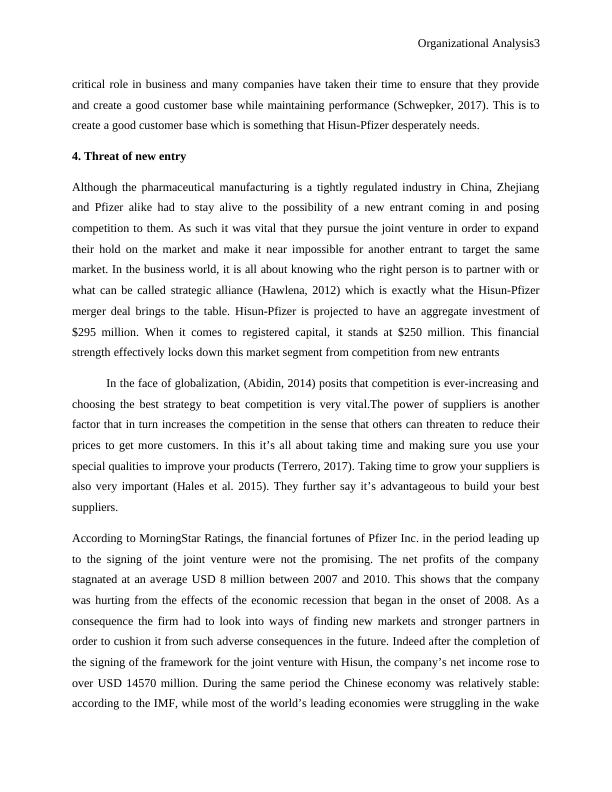Report on Organizational Analysis of Pfizer Inc
Added on 2020-04-07
12 Pages4163 Words65 Views
Organizational Analysis1Analysis of the joint venture between Pfizer Inc. and Zhejiang Hisun pharmaceuticalsNameInstitution

Organizational Analysis2Question One: First off we start by analyzing the deal using Michael E. Porter’s model, thereasons for the joint venture and the involvement of the U.S. and Chinese governments in thedeal.1.Competitive RivalryIn this segment we look at the competition in the Active Pharmaceutical Ingredients (API)manufacturing industry. Notably, in china there is a shortage of top quality API manufacturingcompanies. India is a larger base for most leading API manufacturers in the Asian continent. Itwas therefore prudent for Pfizer and Hisun to close this joint venture to take advantage of thisgap in the industry and establish itself as the first leading API manufacturer in China. MoreoverChinese laws and tax code system favor API manufactured in China. 2. Supplier powerChina is a low cost country. The cost of labor and other factors of production are comparativelylower than in the United States of America. As a consequence, setting up operations in Zhejiangprovince of China would confer Pfizer-Hisun competitive advantage as opposed to Pfizer on itsown operating in the US. In Zhejiang China the supply of labor and other factors of productionare abundant and the likelihood of suppliers manipulating prices to the disadvantage of the jointventure is unlikely. This seems exactly what Hisun-Pfizer needs to do to stay at the top byproducing better products. Taking time to grow your suppliers is also very important (Hales et al.2015). They further say it’s advantageous to build your best suppliers.3. Buyer powerMichael E Porter postulates that where a business is dealing with a few savvy customers thenthey have power over the business and can dictate terms. They may also easily switch to otherrival alternatives for the same goods or services. But where the business is dealing with a largenumber of customers, its power over customers is increased. China’s ever growing populationwhich stands at not less than 1.3 billion offers the kind of large market base that Pfizer-Hisunwould need in order to have the upper hand when dealing with customers. This must havebeen a fundamental reason for the pursuit of this joint venture. The power of customers plays a

Organizational Analysis3critical role in business and many companies have taken their time to ensure that they provideand create a good customer base while maintaining performance (Schwepker, 2017). This is tocreate a good customer base which is something that Hisun-Pfizer desperately needs. 4. Threat of new entryAlthough the pharmaceutical manufacturing is a tightly regulated industry in China, Zhejiangand Pfizer alike had to stay alive to the possibility of a new entrant coming in and posingcompetition to them. As such it was vital that they pursue the joint venture in order to expandtheir hold on the market and make it near impossible for another entrant to target the samemarket. In the business world, it is all about knowing who the right person is to partner with orwhat can be called strategic alliance (Hawlena, 2012) which is exactly what the Hisun-Pfizermerger deal brings to the table. Hisun-Pfizer is projected to have an aggregate investment of$295 million. When it comes to registered capital, it stands at $250 million. This financialstrength effectively locks down this market segment from competition from new entrants In the face of globalization, (Abidin, 2014) posits that competition is ever-increasing andchoosing the best strategy to beat competition is very vital.The power of suppliers is anotherfactor that in turn increases the competition in the sense that others can threaten to reduce theirprices to get more customers. In this it’s all about taking time and making sure you use yourspecial qualities to improve your products (Terrero, 2017). Taking time to grow your suppliers isalso very important (Hales et al. 2015). They further say it’s advantageous to build your bestsuppliers.According to MorningStar Ratings, the financial fortunes of Pfizer Inc. in the period leading upto the signing of the joint venture were not the promising. The net profits of the companystagnated at an average USD 8 million between 2007 and 2010. This shows that the companywas hurting from the effects of the economic recession that began in the onset of 2008. As aconsequence the firm had to look into ways of finding new markets and stronger partners inorder to cushion it from such adverse consequences in the future. Indeed after the completion ofthe signing of the framework for the joint venture with Hisun, the company’s net income rose toover USD 14570 million. During the same period the Chinese economy was relatively stable:according to the IMF, while most of the world’s leading economies were struggling in the wake

Organizational Analysis4of the financial crisis of 2007-09, China accounted for more than half the increase in world GDPandremained almost unshaken, standing out as the engine of growth in the globaleconomybecause of the governments bailout expenditure on Chinese firms and the public sector.This made China a desirable market to venture in for Pfizer.The involvement of the two governments in the negotiations leading up to the sealing of the dealis yet another factor that facilitated the formation of this joint venture. The Chinese governmentmust have been in support of the joint venture and subsequent setting up of operations in Fuyang,Zhejiang province of china as this would locate production of the generic medicines closer to theChinese consumers as well as create job opportunities for the people of China. The first signing of the Memorandum of Understanding to initiate the joint venture betweenHisun and Pfizer took place during the visit by a delegation from the Zhejiang ProvincialGovernment to the U.S. in June 2011. This would be followed by the visit by Chinese VicePresident, Mr. Xi Jinpingto the U.S. in February 2011 which saw the two companies sign theFramework Agreement. This was done at the Sino-US Economic & Trade Cooperation Forumheld in Los Angeles at a ceremony graced by Mr. Xi and U.S. Secretary of Commerce, JohnBryson, as well as several other senior officials from China and the U.S. This high levelinvolvement of senior government officials from both countries set the establishment of the jointventure in motion. The U.S. government was driven by market seeking motives and wasinterested in seeking new market for Pfizer, one of its leading pharmaceutical companies throughthis deal while China sought an efficient way to produce some of the best generic medicinescloser to its people. The U.S. stands to rake in millions in profit from making foreign directinvestments in China and Asia by extension through opportunities that are availed by this jointventure. Question 2: The business partnership with its associated risks compared to Pfizer Inc.’spartnership with Hospira Inc.The deal signed between Pfizer Pharmaceuticals and Hisun Zhejiang is a joint venture.Theobjectiveof this joint venture is to enable Hisun-Pfizer to take advantage of the productportfolio enjoyed by Hisun, better utilize the broad market outreach as well as the expertise ofPfizer in research and development and commercialization of branded generic drugs. The joint

End of preview
Want to access all the pages? Upload your documents or become a member.
Related Documents
Woolworths International Marketing Plan Assignmentlg...
|5
|808
|172
Using Strategy Development Tools: Examples of Australian Pharmaceutical Industries Ltd and Deloitte Consultinglg...
|12
|1914
|151
An Analysis of a Strategic Business Issue within Pfizerlg...
|24
|6712
|372
Emerging Markets and Opportunities in the Pharmaceutical Industry: Brazil and Indialg...
|18
|2941
|68
Strategic Analysis Reportlg...
|16
|4536
|171
External and Internal Analysis of GlaxoSmithKline (GSK)lg...
|15
|3380
|258
